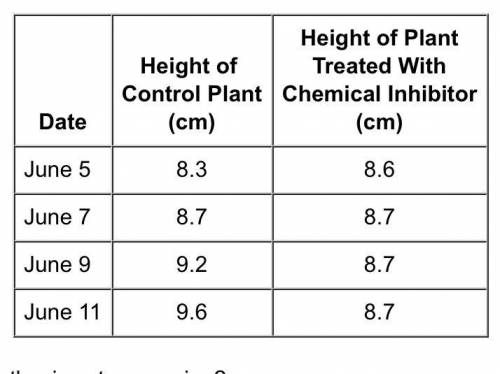
Chemistry, 14.04.2020 14:36, charliesteioff14
A scientist did an experiment using a chemical inhibitor that stops photosynthesis for a certain type of plant. He grew two plants, giving the chemical to one plant and not to the other. Both plants were given equal amounts of water and sunlight. He then measured the growth of both plants as shown in the table below.
(Picture)
Why did the plant that could not photosynthesize stop growing?
A.
It did not have enough other plants to consume for food.
B.
It did not have enough food for building materials.
C.
It did not have enough light to grow.
D.
It did not have enough water to grow.


Answers: 1
Other questions on the subject: Chemistry

Chemistry, 22.06.2019 00:30, amaliathornton22
Microtubular fibers that assist in the movement of chromosomes during nuclear division in conjunction with proteins, makes up the small and large organelle pieces that assemble prior to translation three-base nucleotide sequence that can complementarily pair with the functional transcript, allowing a particular material to be brought to a ribosome particular time in the cell cycle when the cell’s systems determine if the cellular conditions are appropriate to continue through the cycle time in the cell’s cycle when proteins are made and organelles are duplicated enzyme that allows proper nucleotide bonding during transcription specific dna sequence which will initiate gene transcription division of the cell’s cytoplasm specific bond that forms between two amino acids when a carboxyl group binds to a amino group three-base sequence that does not code for a particular amino acid a paired organelle which facilitates the formation of movement microtubules time in the cell’s cycle when the microtubular structures exert an equal pressure on the cell’s genetic material
Answers: 2

Chemistry, 22.06.2019 07:40, caleb19moody
21. consider the following chemical reaction: n2+ o2 2 no if 10.0 g of n2 reacts with excess oxygen then how many grams of no can be formed? a) 10.7 g b) 21.4 g c) 32.9 g d) 42.8 g page 4 of 8
Answers: 2


Chemistry, 23.06.2019 02:50, igraha17
Dumbledore decides to gives a surprise demonstration. he starts with a hydrate of na2co3 which has a mass of 4.31 g before heating. after he heats it he finds the mass of the anhydrous compound is found to be 3.22 g. he asks everyone in class to determine the integer x in the hydrate: na2co3·xh2o; you should do this also. round your answer to the nearest integ
Answers: 2
Do you know the correct answer?
A scientist did an experiment using a chemical inhibitor that stops photosynthesis for a certain typ...
Questions in other subjects:
















